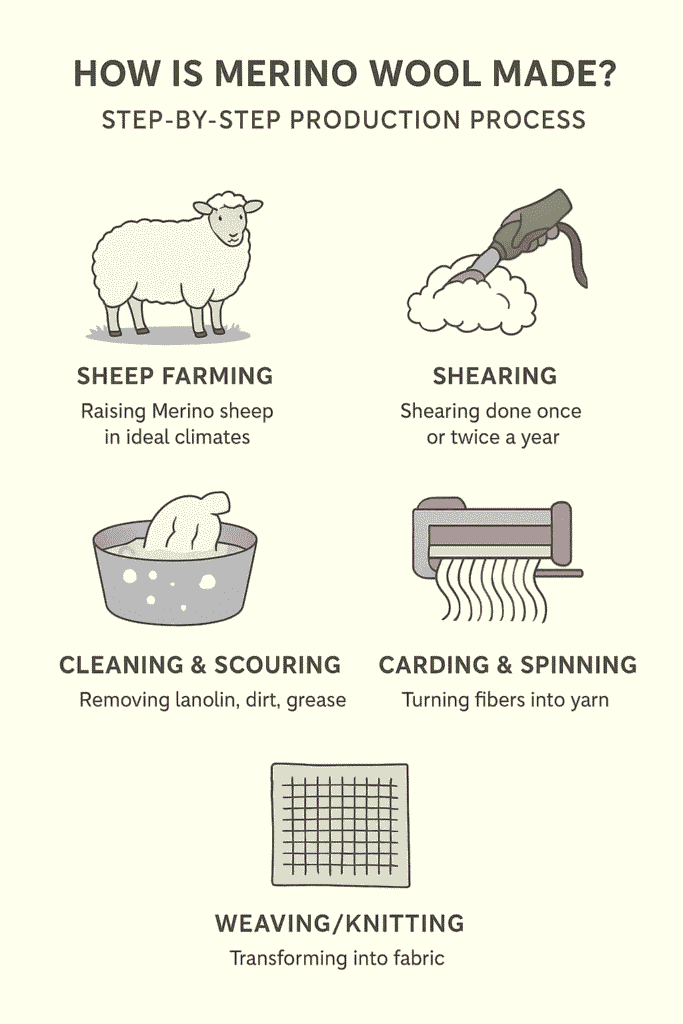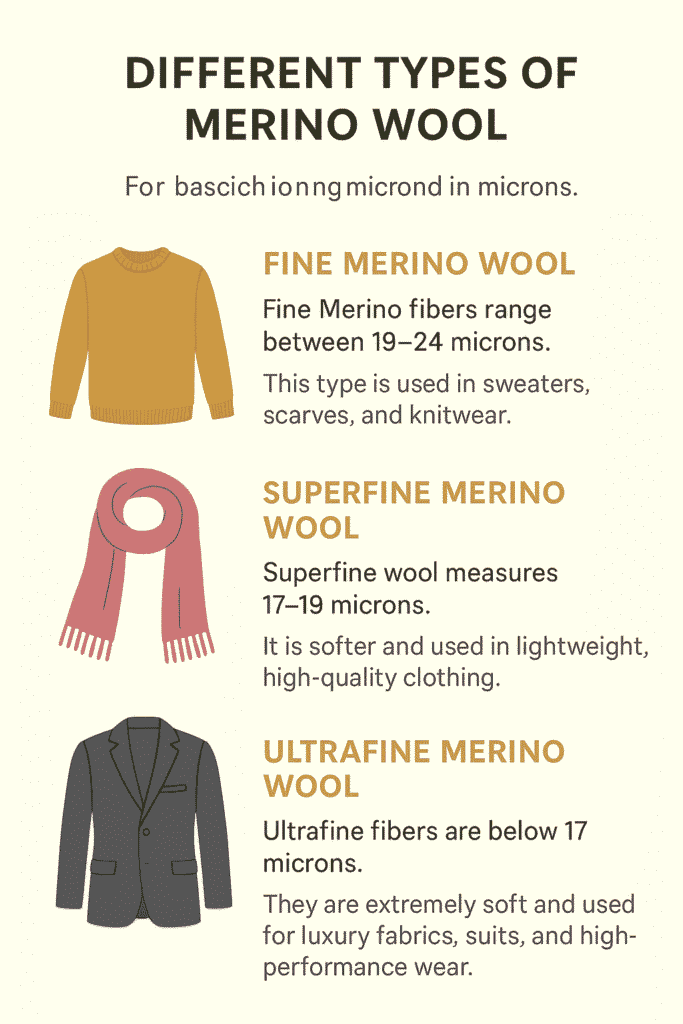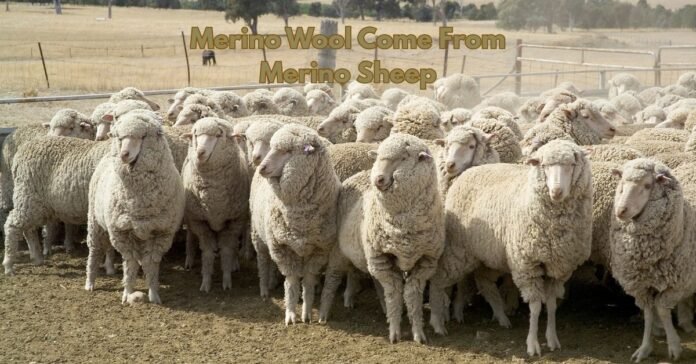Introduction-
The Merino breed of sheep is the source of Merino wool. Today, Merino sheep are bred primarily in Australia and New Zealand, but their origins are traced to Spain. Merino wool is considered one of the finest wool in the world and is highly prized in the garment and textile industry.
This article will discuss where it comes from, how it is made, and the reasons for its increasing value from the past to the present. History, distinctive features, and global uses along with the topic of sustainability will all be covered. It is anticipated that the reader will realize that Merino wool is one of the many fibers available; however, it is also recognized as a significant natural resource.
What Is Merino Wool?
It is derived from the fleece of the Merino sheep. Unlike sheep wool. It is also fine and soft enough to be worn directly against the skin. the microscopic dial diameter of Merino wool distinguishes it from conventional wool which often feels coarse and itchy.
It is soft to the touch due to the delicacy of the individual fibers which range between 15 and 24 microns. The fibers bend. Which is why it does not have the scratchy qualities of the other types of wool. In summary, Merino wool, along with other keratin products, is made from the protein constituent of sheep hair.
Its natural composition bestows Merino wool with exceptional durability, elasticity, and moisture wicking abilities. Therefore, it is a widely used fabric in luxury and performance clothing as well as in outdoor wear.
The Origin of Merino Wool: History & Geography
The inception of Merino wool traces back to Spain, where Merino breed sheep were innovatively cultivated and meticulously guarded by Spanish royalty during the mid medieval ages. This wool was prized as one of the most valuable materials during that time period as the cultivation of sheep was done on the utmost precision. In the 18th century, this breed was exported to Australia, New Zealand, and South Africa.
As of today, Australia happens to be the leading manufacturer of this, with New Zealand and South Africa closely trailing behind. This is as a result of their ideal environmental conditions of warm winters, dry summer seasons, and wide expanses of grazing land.
The Merino sheep population is currently bred on almost every continent, with the largest consumers being New Zealand and Australia. This is as a result of their high flock density and developed textile industries that specialize in refined Merino wool.
How Is Merino Wool Made? Step-by-Step Production Process

Sheep Farming
Merinos are reared in big open fields where their climates favor them. They are given healthy food, clean water, and nice shelter by their farmers. The healthier the sheep the finer and stronger the wool fibers. Best sheep farming practices guarantee quality in the fleece and healthiness of the animals.
Shearing
It is sheared once or twice a year in spring or early summer. The fleece is taken off with electric clippers by skilled workers and it does not hurt the sheep. The process cools the sheep when the weather is warmer and gives the fleece to produce. Shearing must be done in an ethical manner so that the sheep is comfortable and safe.
Cleaning & Scouring
Lanolin, dirt and natural grease are present in the freshly shorn fleece. The wool is scoured in warm water and mild detergents as a preparation. This purifies them and results in soft and clean fibers. Lanolin may be recovered at this point, and reused in skincare and cosmetic products.
Carding & Spinning
After cleaning, the fibers are carded so as to align them and separate. Wool is combed at carding machines into thin smooth sheets of wool which may be spun. The fibers are then twisted into strong and fine strands and are ready to be used in textile production. This is an important stage in making the wool durable yet soft yarn.
Weaving or Knitting
Spun yarn is changed into fabric by weaving or knitting. Weaving makes tough and stiff fabrics, whereas knitting makes stretchy and flexible fabrics. They are then made into sweaters, high-performance active wear, etc. This is the last stage in the process of converting raw fleece into a wearable.
Why Is Merino Wool Special?
- softness: Merino wool fibers are very fine (usually less than 20 microns). This extreme fine size translates to a very soft and smooth feel of Merino clothing against the skin; unlike the more coarse wools.
- Breathability: Merino fibers have crimps and scales that give the fabric small air holes. These pockets allow moisture vapor to escape and let the skin breathe making Merino garments incredibly breathable. Merino will not make you feel sweaty even when he is keeping you warm.
- Odor Resistance: Lanolin, a waxy material, is naturally present in Merino wool, and it repels odor-producing compounds. Therefore, Merino clothes are odor resistant and can be used many times without washing. That is why hikers and all other travelers tend to use Merino clothes more often than other kinds of clothes; it does not go bad after a long time.
- Temperature Control: Merino wool is the best in thermoregulation. Its fibers work to insulate when cold and wick moisture when hot to cool the body. As a matter of fact, Merino has a way of keeping you cool in summer and warm in winter. Such versatility enables its use in a large number of climates and activities.
- Natural Fiber Quality: All these special characteristics are the result of the special structure of the fiber and the painstaking procedure of Merino. Extensive spinning and cleaning combined with the ultra-fine scale-textured fibers produces a wool that is soft, resilient, and high-performing.
Different Types of Merino Wool

Fine Merino Wool
Fibers described as Fine Merino range from 19 to 24 microns in diameter. This puts them in the category of soft; however, Merino is tough enough to endure everyday wear. Its unique properties make Fine Merino ideal for sweaters, scarves, and other types of knitwear. Fine Merino is a tad bit thicker in comparison to the rest of the Merino wool products. Consequently, it provides warmth and durability. This is the reason why it is the most used grade in the world.
Superfine Merino Wool
Superfine Merino includes wool that is microns in diameter in comparison to the other Merino wool products. It is the lightest and softest among the Merino wool products. The delicate wool is ideal for premium garments that hug the body. Its breathable and silky texture enhances everyday garments, turning them into dress shirts and high-end knitted garments. This grade balances between tight weaves and everyday ease. That is why superfine merino is extremely common in the global market.
Ultrafine Merino Wool
It is below 17 microns in diameter, classifying it as one of the softest ultrafine Merino garments streaked with luxury, high-end fashion fabric, tailored suits, and luxury performance active apparel. Ultrafine Merino garments ultrafine garments, as cherished as they are for their unbroken elegance, exposure the ultra premium side of Merino wool production.
Global Uses of Merino Wool Today
It has come very far from an old sweater. Its applications around the world can be classified under two headings:
Fashion Related Uses:
Expensive men’s suits and coats.
Casual knitwear like sweaters and cardigans.
Lightweight scarves, shawls, and other accessories.
Outdoor & Sportswear Uses:
Ski and hike base layers.
Thermal gloves and socks.
Fitness and sports apparel.
Thanks to technological advancements, the high-end fashion market and the high-performance activewear market are dominated by this.
Sustainability of Merino Wool
It is also renewable and biodegradable which makes it very eco-friendly. As we know sheep grow a wool fleece each year which is an unending supply so it doesn’t hurt the eco system. It is a good source of wool since the waste generated by disposed Merino wool fibers is ecological since it gets biosorbed by the environment without generating toxins.
Sustainability revolves around ethical farming too. Animal rights for sheep especially during farming and shearing periods has gained much needed attention in recent years. One popular controversial practice is known as mulesing. Currently mulesed wool is heavily produced since global demand for ethical production has subsidized its usage.
So, when confronted with the question, “Is Merino wool sustainable?” the answer is a definite “yes” provided it comes from responsible farms that balance animal welfare with sustainability.
Conclusion-
What’s actually the source of this wool? -> It is obtained from Merino sheep, predominantly raised in Australia and New Zealand. From the farm to the final fabric, Merino wool entails responsible farming, skillful shearing, washing, and sophisticated production.
What is Merino wool? -> It is highly appreciated for it’s lightweight, comfortable, and breathable attributes, and it’s able to be worn for several days due to it’s odor-resistant and moisture-wicking properties. Its production, history, and fabrication techniques are unique and all contribute to the wool’s top standing in the textile market.
In summary, we love this wool all over the world because of creativity, tradition, and nature. Understanding the origin and its production process gives us the opportunity to appreciate it even more.
Read More>> About this fine wool.
FAQs
During the Middle Ages, Spain strategically developed Merino sheep breeds and guarded their wool, increasing its worth in Europe. Subsequently, the breed was shipped and mass bred in Australia, New Zealand, and South Africa.
Australia also boasts the highest and most renowned quality Merino wool in the world due to the favorable climate and pasture lands. New Zealand also produces quality Merino wool which is highly regarded in the clothing and activewear market.
The first step in the production process is when the sheep are kept out in nice, fresh fields. After one or two years, the sheep are shorn, the fleece separated, washed, then spun to yarn. The yarn is then knitted of woven into materials used for textiles or clothing.
Yes, Merino wool cruelty-free is possible. Because of ethical practices, cruelty-free farms are able to ensure that animals shorn are treated properly, alongside mulesing, as well as other harmful animal care tactics. There are certifications a consumer can look for to ensure animal friendly wool production.
In luxury fashion, it is used for suits, sweaters, and scarves. The outdoor sector also highly appreciates the wool as it is used for base layers, socks, and active wear. All over the world, it brings together softness and comfort, alongside its incredible performance qualities.
